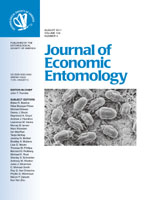The red flour beetle, Tribolium castaneum (Herbst) (Coleoptera: Tenebrionidae), is a major coleopteran pest in flour mills and storage facilities. An aggregation pheromone has been identified for this pest; however, the pheromone is of limited value for population monitoring. To develop more efficient methods to monitor this pest, experiments were conducted to determine whether light functioned as an attractant for the red flour beetle. Light-emitting diodes (LEDs) of various wavelengths were examined as light sources because they produce bright, narrow light spectra. A comparison of responses to light spectra across the visible and UV regions of the electromagnetic spectrum indicated that the beetle was most attracted to near UV LED at a 390 nm dominant wavelength. The use of LEDs in competitive laboratory experiments resulted in a 20% capture of released beetles, compared with a 1% capture with the aggregation pheromone alone. Even more beetles were captured with a combination of LEDs and commercially available chemical lures in traps. LEDs can easily be added onto existing trap designs or new traps can be designed to take full advantage of positive phototaxis.
How to translate text using browser tools
1 August 2011
Evaluating Light Attraction to Increase Trap Efficiency for Tribolium castaneum (Coleoptera: Tenebrionidae)
A. J. Duehl,
L. W. Cohnstaedt,
R. T. Arbogast,
P.E.A. Teal
ACCESS THE FULL ARTICLE
It is not available for individual sale.
This article is only available to subscribers.
It is not available for individual sale.
It is not available for individual sale.

Journal of Economic Entomology
Vol. 104 • No. 4
August 2011
Vol. 104 • No. 4
August 2011
insect vision
LED
pitfall trapping
stored product




